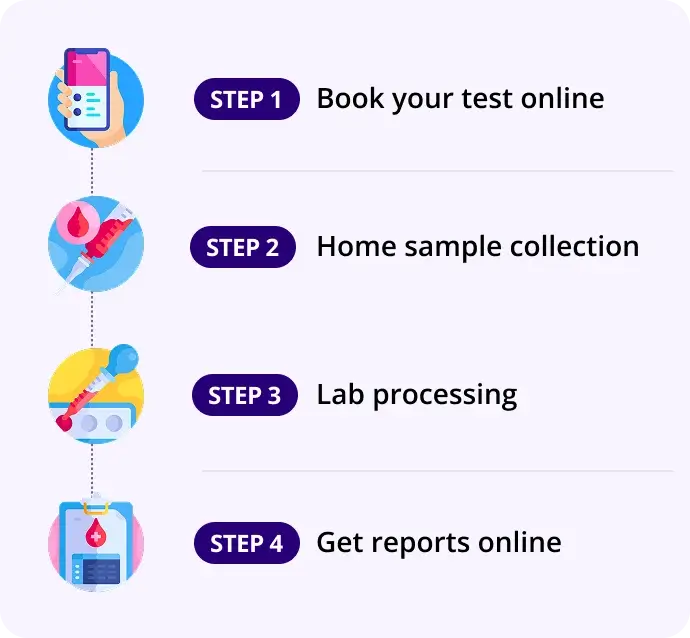Brucella IgM
Unit Test
Report in 132Hrs
At Home
No Fasting Required
Details
Brucella is a genus of gram-negative bacteria that causes brucellosis, a zoonotic infection transmitted to humans from infected animals (especially cattle, goats, sheep, pigs)
₹1,820₹2,345
22% OFF
Brucella IgM Test Information Guide
- Brucella IgM
- Why is it done?
- Detects IgM antibodies produced in response to Brucella infection, indicating acute or early-stage brucellosis
- Ordered when patients present with fever, joint pain, fatigue, and night sweats suggestive of brucellosis
- Used in occupational exposure cases (farmers, veterinarians, slaughterhouse workers)
- Performed as part of differential diagnosis for undifferentiated fever, particularly in endemic regions
- Typically ordered during the acute phase of infection (first 1-4 weeks of illness)
- Used to distinguish acute infection from chronic brucellosis when combined with IgG testing
- Normal Range
- Normal Result: Negative or <1:40 titer (varies by laboratory; may also be reported as <0.8 IU/mL or optical density <0.1)
- Positive Result: ≥1:40 titer or ≥0.8 IU/mL; indicates presence of anti-Brucella IgM antibodies
- Borderline/Equivocal: 1:20-1:40 titer; repeat testing recommended after 7-10 days
- Units of Measurement: Titer (dilution ratio), IU/mL (International Units per milliliter), or optical density (OD) units
- Interpretation: Normal (negative) indicates absence of acute Brucella infection; abnormal (positive) suggests recent or acute infection
- Interpretation
- Positive IgM (≥1:40 or ≥0.8 IU/mL): Indicates acute Brucella infection within the last few weeks; patient likely has active brucellosis
- Negative IgM (<1:40): May indicate no acute infection, chronic infection, early infection before antibody development (window period), or previous infection with immunity
- High IgM Titer (≥1:320): Suggests recent onset of acute infection; more likely to indicate active disease
- Paired Serology (IgM + IgG): IgM+ IgG- = acute infection; IgM+ IgG+ = early-stage or progressive infection; IgM- IgG+ = chronic or past infection
- Rising Titer (Serial Testing): Fourfold or greater increase in IgM between paired samples strongly suggests acute infection
- Factors Affecting Results: Timing of test (early symptoms may show negative results), recent vaccination, cross-reactivity with other infections, immunocompromised status
- Associated Organs
- Primary Organ Systems: Immune system (produces antibodies); reticuloendothelial system (liver, spleen, lymph nodes are primary sites of infection)
- Brucellosis-Associated Conditions: Acute febrile illness, undulant fever, hepatomegaly, splenomegaly, lymphadenopathy
- Systemic Manifestations: Arthralgia and arthritis (especially knees, hips, shoulders), osteomyelitis, endocarditis, meningitis, neurobrucellosis
- Reproductive System: Epididymitis, orchitis, and abortion in pregnancy (particularly in first trimester)
- Potential Complications: Chronic brucellosis with relapsing fevers, chronic arthritis, cardiac complications, neurological sequelae if untreated
- Follow-up Tests
- Brucella IgG Test: Essential to differentiate acute from chronic infection; presence of IgG suggests more advanced or chronic disease
- Blood Culture: Gold standard for diagnosis; performs best in acute phase; may require prolonged incubation (15-30 days)
- PCR (Polymerase Chain Reaction): Useful for confirmation; detects bacterial DNA; particularly helpful in early phase before antibodies develop
- Complete Blood Count (CBC): Identifies anemia, thrombocytopenia, or lymphocytosis associated with brucellosis
- Liver Function Tests: Evaluates hepatic involvement (elevated transaminases common)
- Repeat Serology: Recommended 7-10 days after initial test if initial result is negative or borderline; a rising titer supports diagnosis
- Imaging Studies: Ultrasound or CT scan if complications suspected (hepatosplenomegaly, osteomyelitis); echocardiography for endocarditis
- Monitoring: Post-treatment serology at 3-6 months to document decline in antibody titers; confirms treatment efficacy
- Fasting Required?
- Fasting Required: No
- Special Preparations: None required; routine blood draw procedure applies
- Medications: No medications need to be stopped; continue all regular medications as prescribed
- Patient Instructions: Inform healthcare provider about occupational exposure history, contact with animals, or ingestion of unpasteurized dairy products
- Sample Type: Serum (blood sample collected in a standard vacuum tube, typically a serum separator tube)
- Collection Timing: Best performed during acute phase (first 1-4 weeks of illness); repeat testing after 7-10 days may improve diagnostic yield
- Why is it done?
How our test process works!

